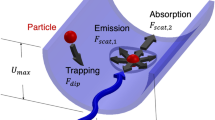Abstract
A Wien velocity filter employs a combination of crossed magnetic and electrostatic fields in order to select the desired velocity of ions. Several microscopes and spectrometers are used as filters to ensure the introduction of a pure ion fraction into the lens, deflecting unnecessary particles which have slightly different energies. The Wien filter is also considered to be a useful device to transport mono-energy protons from a source to an injection system. In its simplest form, the Wien filter has two flat parallel electrodes that are arranged between two flat magnet poles, creating homogeneous electric and magnetic fields which cross each other. However, this type of filter has no focusing effect in the direction of the magnetic field and has an unmatched field distribution, which causes deflections of protons at the entrance and the exit of the filter. At higher magnetic field strengs, for fast protons, the deflection of the trajectories becomes larger; thus, the transport efficiency is reduced. A low-aberration velocity filter is needed for high transport efficiency. Recently, a stigmatic focusing of the filter by using hyperbolic cylindrical magnet pole pieces, which produce an inhomogeneous magnetic field inside the ExB filter, has been suggested. In this research, three types of Wien filters were designed in order to investigate the geometry of the electrodes and the magnet poles, thus minimizing aberrations. Ray-tracing analyses were carried out to estimate the performance of the proposed Wien filters within a useful velocity selector.
Similar content being viewed by others
References
W. Wien, Verh. Phys. Ges. Berlin 16, 165 (1987).
E. Plies, K. Marianowski and T. Ohnoveiler, Nucl. Inst. Meth. Phys. Res. A 645, 7 (2011).
H. Boersch, J. Geiger and H. Hellwig, Phys. Lett. 3, 64 (1962).
R. L. Seliger, J. Appl. Phys. 43, 2352 (1972).
T. Kohashi, H. Matsuyama and K. Koike, Rev. Sci. Instrum. 66, 5537 (1995).
M. Terauchi, M. Tanaka, K. Tsuno and M. Ishida, Microscopy 194, 203 (1999).
K. Tsuno and J. Rouse, J. Elec. Microscopy 45, 417 (1996).
Charged particle optics simulator, SIMION, http://www.simion.com.
Author information
Authors and Affiliations
Corresponding author
Rights and permissions
About this article
Cite this article
Kim, J.H., Kim, YS. Ray-tracing analysis of the Wien velocity filter for protons. Journal of the Korean Physical Society 66, 389–393 (2015). https://doi.org/10.3938/jkps.66.389
Received:
Published:
Issue Date:
DOI: https://doi.org/10.3938/jkps.66.389




